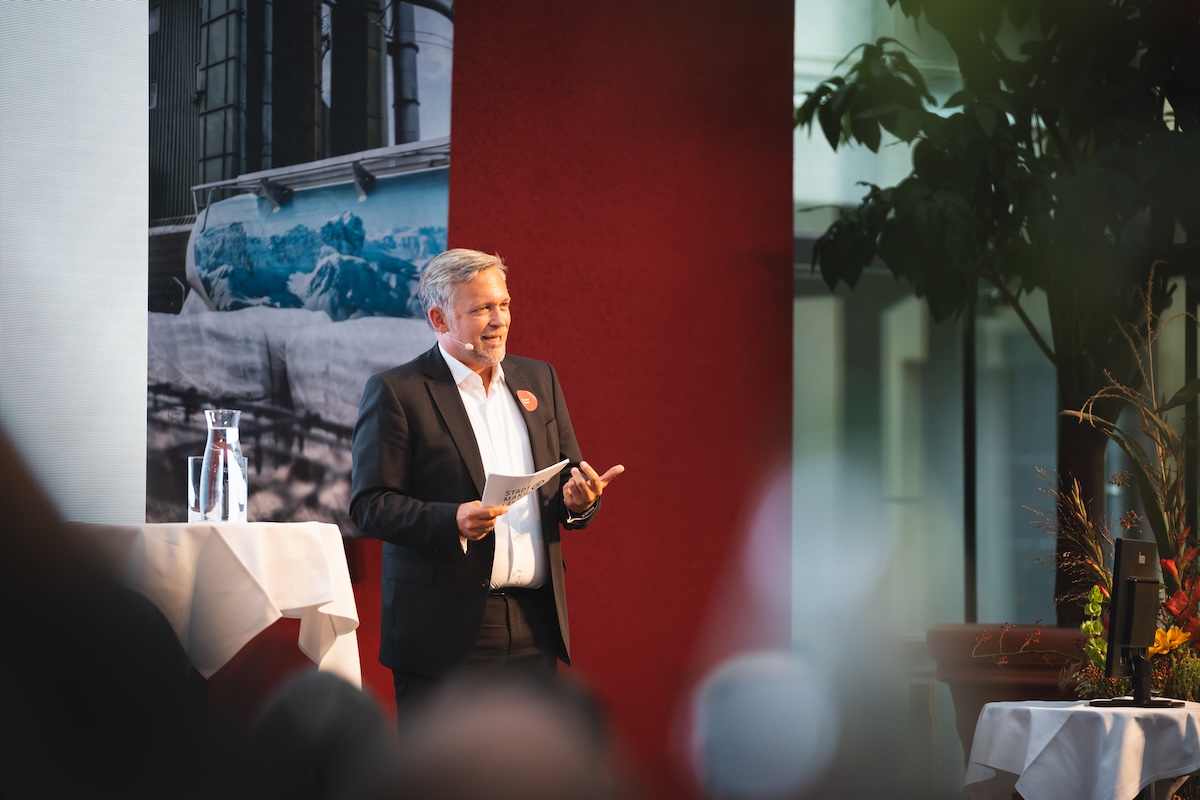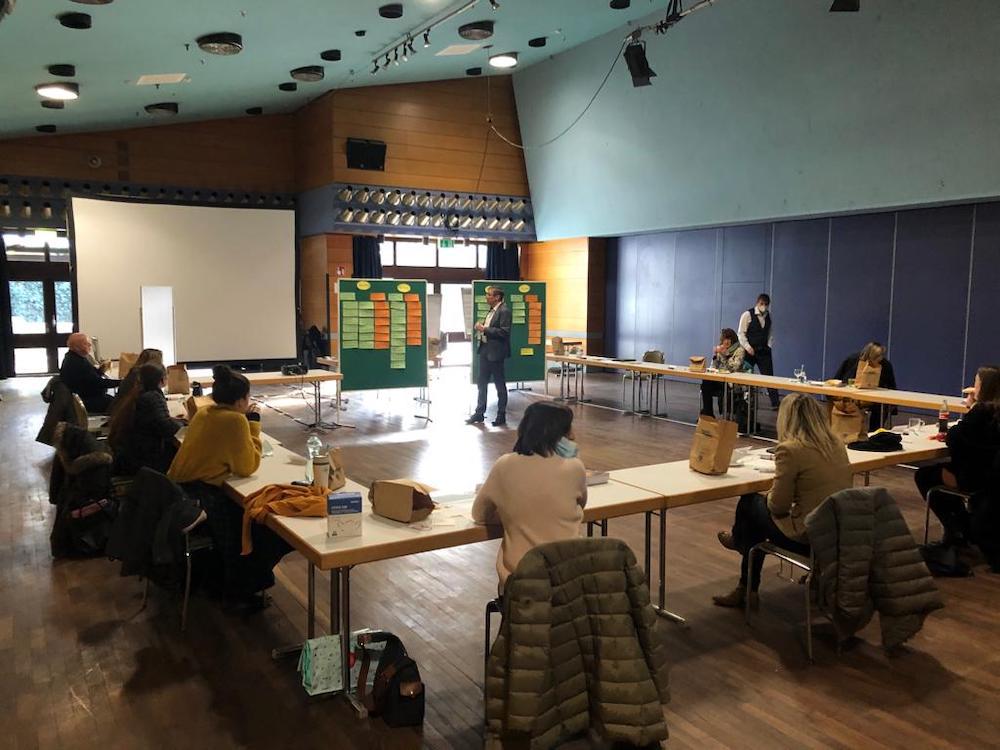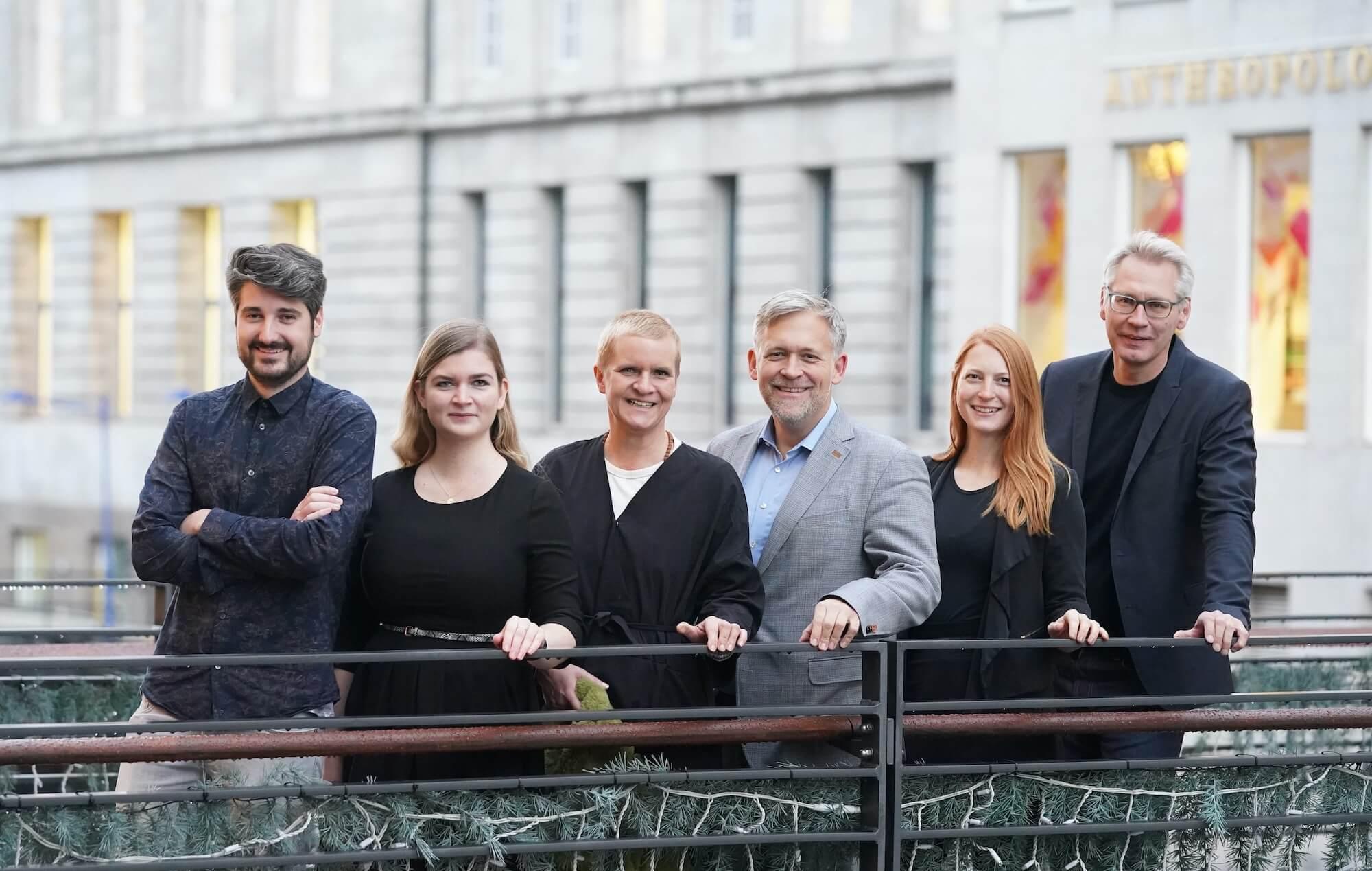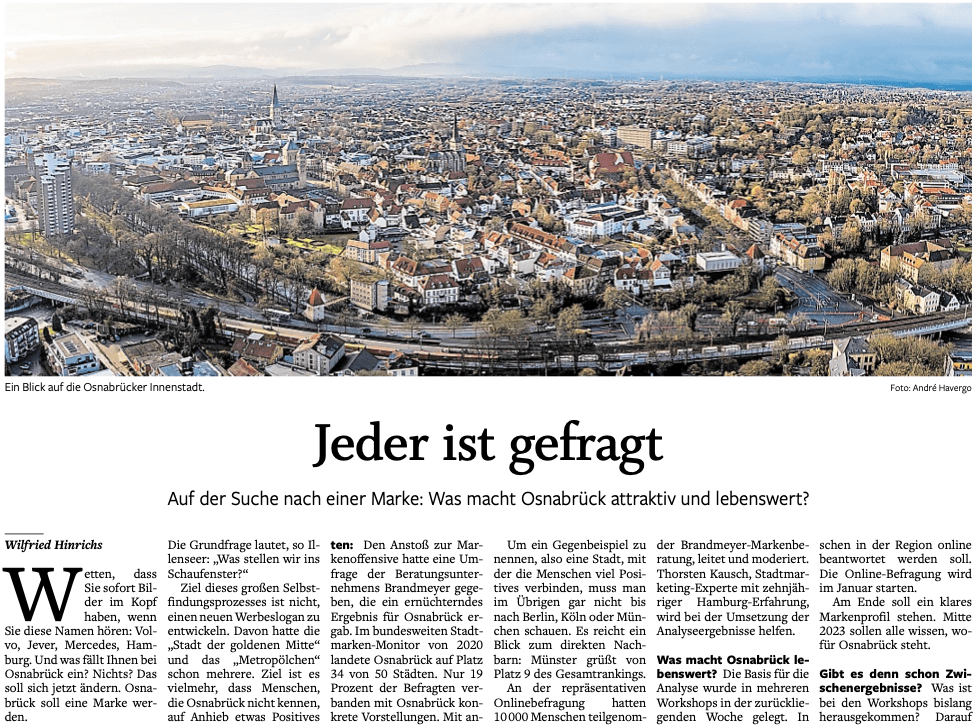CONTENT

Destination management is much more than destination marketing
Today, cities and regions are competing more intensely than ever for citizens, guests, talent and investment. The challenges facing urban spaces – including digitalization, demographic developments and the transformation of city centres – require coordinated, new solutions.
This is precisely where destination management (DM) gains relevance. It describes the strategic management of an urban experience in which tourism offers, urban infrastructure, culture, trade and quality of life are intertwined. In contrast to pure destination marketing, which focuses on communication and sales measures, destination management also includes general urban processes, e.g. visitor guidance and thus parts of traffic management, quality and infrastructure development as well as monitoring.
As a rule, destination management is handled by a destination management organization (DMO), which pursues overarching goals such as image building, improving the quality of stay, developing experiences and increasing tourism value creation.
Abstract:
Laura Ebeling shows why place marketing and destination marketing should see destination management (DM) as a joint task. She explains key terms and roles, names success factors and gives five specific recommendations for action for integrated destination management.
Destination, DM and DMO: classification of the key terms
Destination
A destination is a clearly defined geographical area of experience – in this case the city as a closed travel and recreation area.
Destination marketing
Destination marketing comprises the communication and sales measures for positioning the city as a travel destination and generating demand.
Destination Management (DM)
Destination management (DM) is a holistic, strategic management process that combines planning, offer development, infrastructure, stakeholder coordination, quality management and communication.
Destination Management Organization (DMO)
A destination management organization (DMO) is an institution that is organized in the form of a limited liability company, a proprietary company or an association and bundles and is operationally responsible for all destination management tasks.
In practice, destination management is also undertaken by place marketing or destination marketing organizations that think and act holistically. Examples of this are Hamburg Marketing GmbH or StaRT – Place Marketing and Tourism Reutlingen GmbH.
It is important to note that without a coordinating unit for destination management, parallel structures, contradictory lines of communication and conflicting goals between the groups of stakeholders from politics, business, culture and civil society quickly arise.
Destination marketing and place marketing – a logical symbiosis
Place marketing and destination marketing have a common goal: to position the city as an attractive place worth living and visiting. However, their perspectives differ:
- Destination marketing mainly communicates to the outside world – it develops tourist experiences, coordinates service providers and markets the city as a travel destination.
- Place marketing, on the other hand, is primarily directed inwards, strengthens the identification of citizens, positions the city as a place to do business, work and live and provides impetus for urban society and local businesses. Place marketing uses these activities to create points of contact for external communication.
It is precisely in these interfaces between place marketing and destination marketing that the potential for a strong symbiosis in the form of destination management lies. Because eA consistent and convincing city image is created when city identity, tourism offers and external communication are strategically coordinated. For example, events that are planned as part of place marketing offer potential for tourist travel. At the same time, strong demand from tourists can provide new impetus for the revitalization of the city centre or the development of urban experience spaces.
“In practice, the boundaries between place marketing and destination marketing often become blurred. Hence the urgent appeal: clarify roles and tasks and join forces – for a destination management that sees the city as a whole and from which everyone benefits.”
For this collaboration to succeed, regular coordination formats, strategic coordination of measures and a shared understanding of the potential of the city brand are required . The brand acts as a unifying element – both internally and externally. It creates identification, guides content and enables a uniform narrative across all channels.
It is crucial to build the brand on the identity and strengths of the citizens and to market it to the outside world. If you don’t involve citizens, you run the risk of content not fitting the city and appearing artificial.
Distribution of tasks between destination management and place marketing – an overview
| Field of action | City marketing (stronger) | Destination management (stronger) | Joint potential |
|---|---|---|---|
| City brand & identity | Internal branding, citizen loyalty | External brand management for guests | Consistent city image internally and externally |
| Events & activities | City festivals, participation campaigns | Event communication, travel motives | Extension of length of stay |
| City center & adventure spaces | Location enhancement, quality of life | Reasons to visit, staging of experiences | Attractive spaces for all target groups |
| Communication & Campaigns | Location image, addressing skilled workers and companies | Travel incentives, tourism campaigns | Coordinated communication across all channels |
| Stakeholder management | Network with business, culture, civil society | Networks with tourism service providers | Synergies through joint stakeholder participation |
| Data & monitoring | Location indicators, image analysis | Guest numbers, booking behavior, added value | Holistic measurement of urban development |
Success factors for integrated destination management
Common strategy as a basis
Integrated destination management requires place marketing and tourism to develop a common strategic basis. This includes
- Clear positioning
- Defined target groups
- Coordinated worlds of experience
- Prioritized fields of action
The joint strategy forms the basis for synergetic action and consistent communication.
Involve stakeholders at an early stage
The early and continuous involvement of relevant stakeholders is also key to success . Key players from the fields of tourism, business, culture, administration and citizens should be integrated as early as the strategy phase, for example through a stakeholder map and dialogical participation formats.
However, involvement should not end after the conception phase. Stakeholders are also important partners in the implementation phase in order to establish measures in the long term and develop them further together.
It is important to carry out a regular check-up and critically question whether new stakeholders need to be involved – or whether existing ones need to be dropped. After all, stakeholder management is not a snapshot, but a changing process.
Establishing an authentic city brand
The city brand forms the central anchor – also in destination management. It ensures coherent communication, strengthens the emotional bond between citizens and serves as the basis for external marketing. It is important that it does not remain abstract, but is based on authentic areas of strength. These should be identified in participatory processes and linked to concrete offers.
One example is Bitburg: the town uses its historical identity – from Roman times to the “Gäßestrepper” and the brewing tradition – as profile-building elements. These are anchored in both place marketing and tourism communication. This enables credible narratives that can be experienced on site, for example through themed city tours or event formats.
Strengthening strengths – through images, texts, platforms
A thematically focused topic setting that builds on the identity-based city profile creates additional added value. This can be done, for example, by providing materials such as image data and text modules or by setting up central platforms. This creates a uniform city image across all channels – and in the best case scenario, citizens identify with their city.
An example from Menden: In a photo competition, the citizens of Menden are regularly asked to submit pictures on specific topics. Through participatory support from within, Menden can strengthen its brand image to the outside world – and build and expand its own Menden media database.
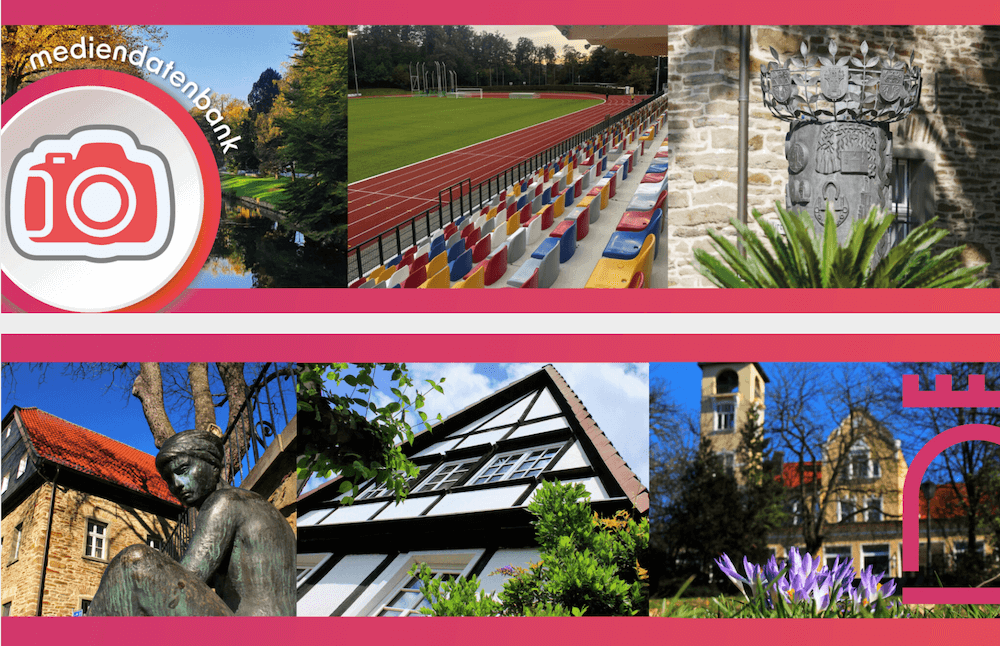
Impressions from the Menden media database – fed by the citizens, coordinated by place marketing (source: www.stadtmarketing-menden.de/mediendatenbank/)
Best practice for dovetailing place marketing and destination management
The city of Reutlingen in Baden-Württemberg shows how place marketing and destination management can be successfully interlinked. The organizational bundling of both areas in the Stadtmarketing und Tourismus Reutlingen GmbH (StaRT) has enabled a clear strategic orientation to be achieved.
The campaign “You can’t like Reutlingen. Only love.” was developed in a broad-based participation process. It combines identity, experience and location profile. Public and private partners work together in mixed committees to implement the strategy. Offers are communicated via the central platform visitreutlingen.de, while data analyses help to measure impact and potential.
The dovetailing is particularly evident in the city center: Thematic tours, experience formats and a coordinated design strengthen the profile and create a noticeable quality of stay for guests and locals alike.
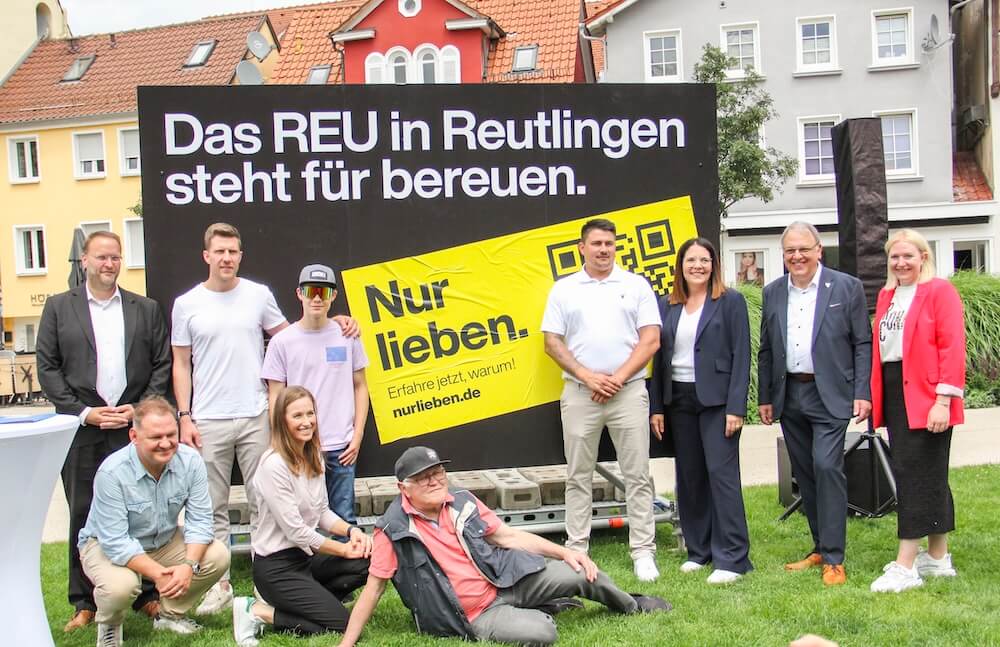
StaRT Managing Director Anna Bierig and Lord Mayor Thomas Keck (from right) with team in front of a poster of the Nur-lieben campaign in Reutlingen. With a lot of self-irony, the campaign has been radiating inwards – and outwards – since 2024 © StaRT
5 Recommendations for action for place marketing and tourism organizations
For place marketing and tourism to work together successfully, clear structures, common goals and coordinated communication are needed. The following five recommendations point the way towards integrated destination management.
Conclusion: Destination management as a task for the future
Integrated destination management is much more than just a marketing tool: it is the strategic approach to bringing a city’s potential to life, strengthening its identity and working together with citizens, guests and partners to create a liveable and sustainable city.
The key lies in a coordinated strategy, clear role models and structured coordination processes. A A strong city brand, which is developed from the identity and strengths of the city, forms the unifying element: it creates orientation, trust and recognizability – for citizens and guests alike.
“When place marketing and destination management are brought together in terms of organization and content, the result is more than the sum of its parts. Tourist experiences become part of everyday urban life, identity can be experienced, communication becomes more consistent – and the city benefits as a whole.”
At the same time, integrated destination management is is a participation project. It thrives on the active involvement of stakeholders from administration, business, culture, tourism and civil society. The strategy can only be effective in the long term if all relevant players are involved from the outset.
For cities, this means that now is the right time to question established structures, clarify interfaces and explore new paths together. After all, a liveable, competitive and future-oriented city can only be created if it is managed coherently and strategically, both internally and externally.

Laura Ebeling
Laura is project manager for city brands and city marketing. Her home town? The green, liveable Braunschweig
